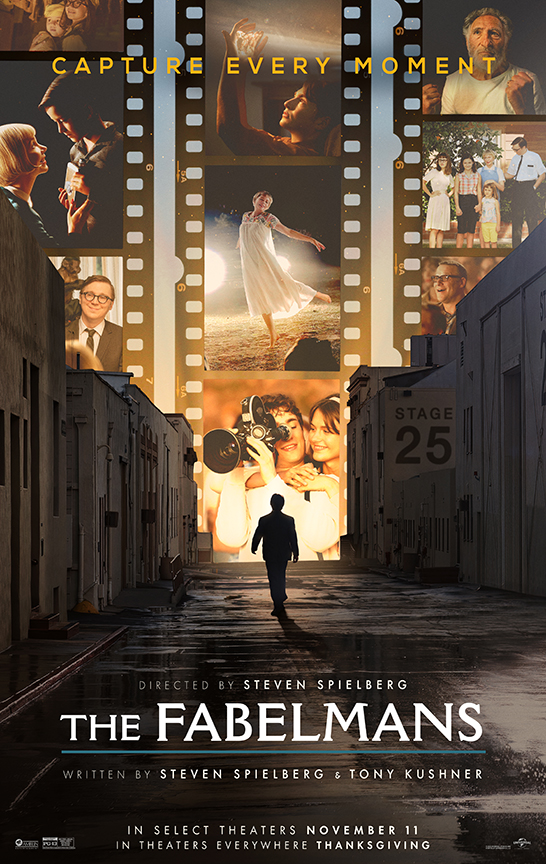Lee: ‘Fabelmans’ uses imaginative lens to tell Spielberg’s story
“The Fabelmans” brings a new imaginative lens to cinema through the retelling of Spielberg’s upbringing.
January 24, 2023
Steven Spielberg’s latest film “The Fabelmans” released in theaters on Nov. 23. Intended to be a semi-autobiographical look into Spielberg’s childhood, “The Fabelmans” features Sammy Fabelman representing Spielberg himself, a prodigious directorial talent with ambitious dreams of expression through film.
The film opens on a wintry day in 1952. Two parents and a curious child stand in a snow-streaked line outside a movie theater. Both parents describe the magnificence of film to their son Sammy with their own characteristic fascinations. The fatherly Burt, portrayed by a spectacled and unassuming Paul Dano, describes the phenomenon in purely analytical terms: The brain mistakenly translates the stolid flicker of frames as a living, moving illusion. In an antithetical approach, Sammy’s mother Mitzi describes the technological miracle with magical flair, describing movies as artistic expression and imaginative gateways into the subconscious creative. It is this ideological difference between the two — the logical versus the poetic — that drives the film’s relational conflicts and provides a critical hinge for the rest of its themes to rest on.
Sammy clearly inherited his mother’s poeticism, and, after that winter showing of “The Greatest Show on Earth,” develops a fascination — or rather an obsession — with the silver screen. One particular incident in the “The Greatest Show on Earth,” featuring a train romantically derailing, forms the basis of Sammy’s lifelong cinematic fixation. Using his father’s toy train cars and cabins, he recreates the crash scene, which is burned into his memory like a harshly lit roll of projection film. His father disapproves of this undertaking. He believes his train cars are only meant for their proper, intended use, so he confiscates the models. Sammy, however, is not satisfied with this outcome.
Sammy’s mother sympathizes with his pursuit, allowing him to secretly use his father’s film camera to shoot the scene. He uses it with innate fluency, controlling every aspect of visuality he can over the makeshift set. Sammy’s first encounter with cinematic creation totally enamors him, and from this point forward, he is smitten with an artistic fervor. He continues to use the camera in other more ambitious endeavors, as his thirst for expression becomes unquenchable.
The rest of the film, as opposed to a clear sequential structure, takes place over a series of episodic side plots, focusing on Sammy’s relationships with various influential figures in his life, such as his high school bully, great uncle and girlfriend. Though certain overarching themes weave through the entire plot, the narrative aim of “The Fabelmans” isn’t necessarily cohesiveness. Rather, it is to present a frame of vignettes sketching Sammy’s coming of age and reconciling his personal life with art. This looser structure allows Spielberg as a writer to focus on the events that he felt shaped him the most, intentionally centering on the themes that impacted his adulthood.
“The Fabelmans” is an undeniable passion project for Spielberg, a fact that suffuses a twinge of nostalgia into each aspect of it. The cinematography is cool and hazy, embodying Spielberg’s sentiment-rimmed — and at times uncertain — childhood memory. The dialogue feels effortlessly weighty, though it is often well peppered with lines of light humor. Spielberg’s nostalgia, however, manifests itself most clearly in this intimacy of the film’s relationships. Although it doesn’t always translate directly into believability, Spielberg writes with a pen rooted in real conversations, real occurrences and — perhaps most importantly — real emotional pain.
This sentimentality doesn’t always work in the film’s favor and, at certain times, degrades into mawkishness. Each character, no matter how deeply flawed, is portrayed with a dubiously merited rose-colored tint. Perhaps this is a result of Spielberg’s reluctance to speak ill of the dead, or an attempt to instill a stubborn thematic redeemability, but because of this, Spielberg at times struggles to seamlessly blend his dramatic, archetypically-Hollywood style with a deeper authenticity.
While the film does have its quieter, heartfelt moments — they certainly do leave a poignant mark — other moments left me in disbelief of “The Fablemans’” genuineness.
Perhaps groundedness isn’t the point of the film. In writing “The Fabelmans,” Spielberg may not have been trying to portray a realistic, physically accurate representation of his childhood. Rather, he may have been attempting to reconcile the defining features of his childhood with the grand passion for cinema that the period developed in him.
In many ways, “The Fabelmans” feels like less of a movie than a two-and-a-half-hour-long tribute to the circumstances and individuals that inspired Spielberg’s cinematic perspective. And, when viewed through that lens, the occasional unrealism seems less important.
What better way is there for Spielberg to represent his tender memory than through the imaginative aspects of film?









